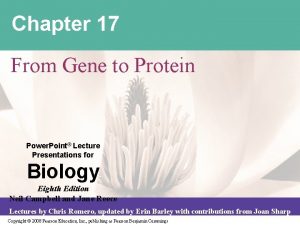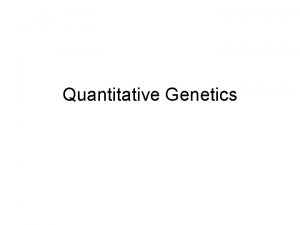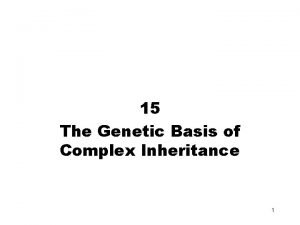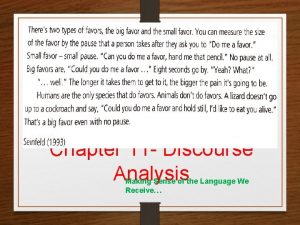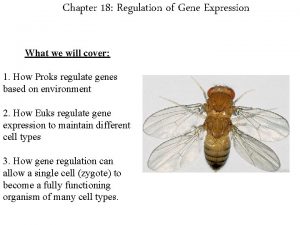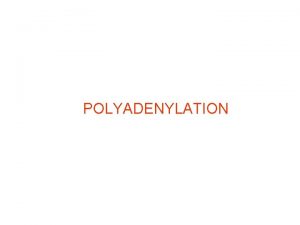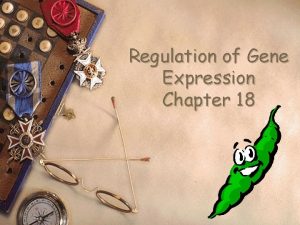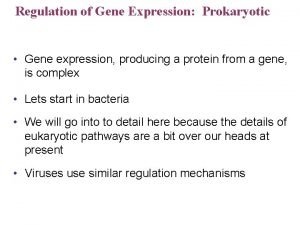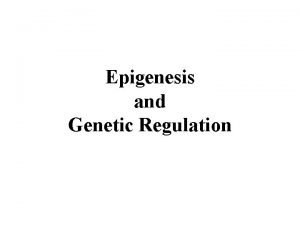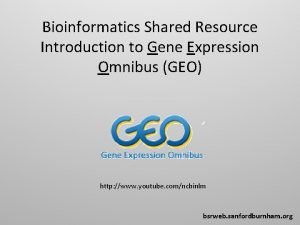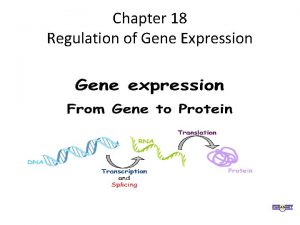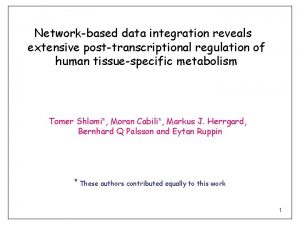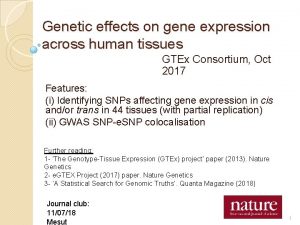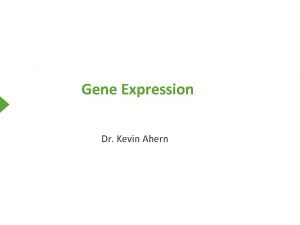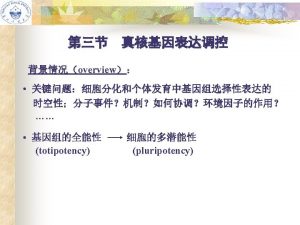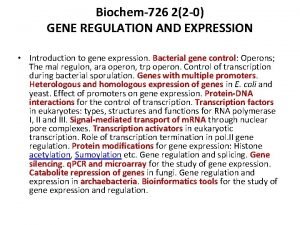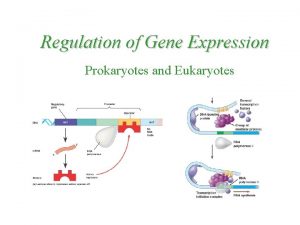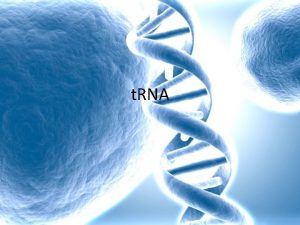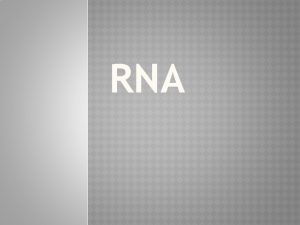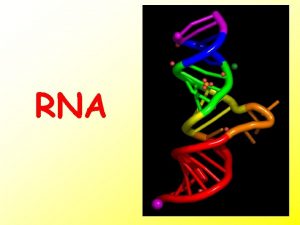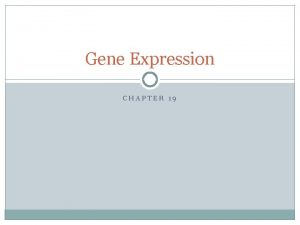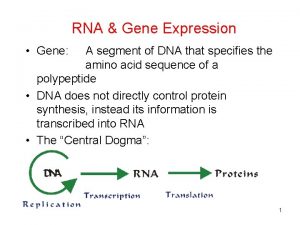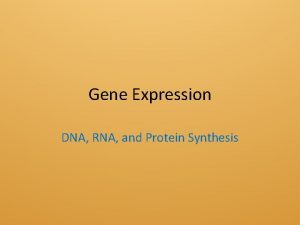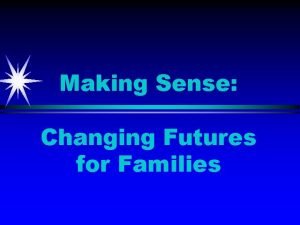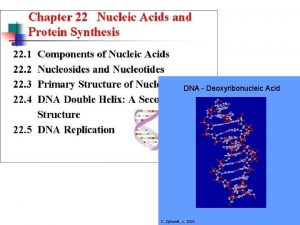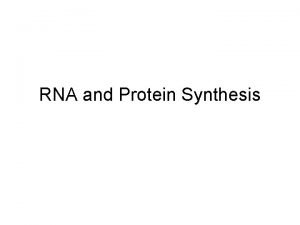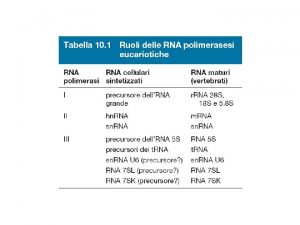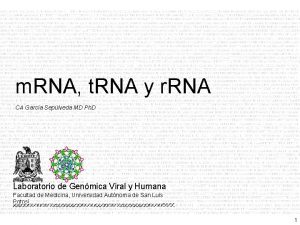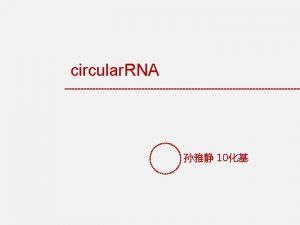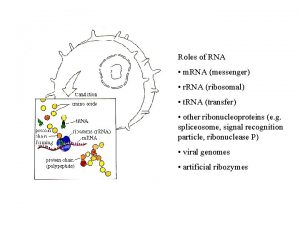RNA Gene Expression Gene Expression Making sense of

















- Slides: 17

RNA & Gene Expression

Gene Expression • Making sense of the code and doing what it says! • Even though the DNA in all of the cells of one organism are the same, they all don’t perform the same functions • Certain cells only “express” certain genes • For example – Eye cells don’t express genes that relate to digestion – Liver cells don’t express genes that relate to reproduction • Genes are expressed by way of proteins

Making a Protein • • • Proteins are built according to instructions coded in DNA But, DNA does not directly make proteins RNA takes information from DNA to the ribosomes where the proteins are made Why? Proteins are made in two steps 1. Transcription (DNA RNA) 2. Translation (RNA Proteins)

DNA vs. RNA • DNA is composed of two strands of nucleotides; RNA is composed of one strand • DNA and RNA have different types of sugars (deoxyribose vs. ribose) • DNA has the bases A, T, C, G; RNA has the bases A, U, C, G (Thymine is replaced by Uracil)

Types of RNA • Messenger RNA (m. RNA): Carries instructions from DNA to the ribosome • Transfer RNA (t. RNA): Translates the instructions into protein building blocks (amino acids) • Ribosomal RNA (r. RNA): What ribosomes are made up of

Transcription • • • A process where information coded on a specific region of DNA (a gene) is transcribed (copied) into m. RNA Occurs in nucleus Steps in transcription: 1. A certain segment of DNA strand unwinds and separates 2. Complementary nucleotides are added (Adenine pairs with Uracil instead of Thymine) 3. DNA strand joins back together and “re-winds” • m. RNA then travels out of nucleus to ribosome

Transcription S U E L C U N N R m s e v a e Al c u n s u le

Three-Letter “Words” • Every three nucleotide bases in m. RNA is called a codon • Each codon is matched to 1 of 20 amino acids • The amino acids will later link up to form proteins codon codon A U G G A A G UC G A C C C A C G G m. RNA strand

Translation • Translation uses the codons on the m. RNA strand to link amino acids together to make proteins at the ribosome Amino Acid t. RNA • t. RNA’s anti-codon joins to n U A odo m. RNA’s codon c i t an codon e m so o codon b i R C A U G G A A G UC G A C U G A C G G

Translation C GG U C UG AG CU U e m o s Ribo codon codon UA C A U G G A A G UC G A C U G A C G G

Translation C AG GG U C UG e m o s o Rib codon C UU A U G G A A G UC G A C U G A C G G

Translation GG U C UG Rib e m o s o codon C AG A U G G A A G UC G A C U G A C G G

Translation GG U e m o s o Rib codon C UG A U G G A A G UC G A C U G A C G G

Translation Rib e m o s o codon A C U A U G G A A G UC G A C U G A C G G

Translation Protein! codon A U G G A A G UC G A C U G A C G G

Translation

• http: //www. youtube. com/watch? v=4 PKj. F 7 Oum. Yo
 Protein power point
Protein power point Dominant genetic variance
Dominant genetic variance Narrow sense heritability vs broad sense heritability
Narrow sense heritability vs broad sense heritability Gene by gene test results
Gene by gene test results Making sense of discourse
Making sense of discourse Chapter 18 regulation of gene expression
Chapter 18 regulation of gene expression Gene expression
Gene expression Chapter 18 regulation of gene expression
Chapter 18 regulation of gene expression Trp operon
Trp operon Lyonization of gene expression
Lyonization of gene expression Gene expression omnibus tutorial
Gene expression omnibus tutorial Chapter 18 regulation of gene expression
Chapter 18 regulation of gene expression Gene expression
Gene expression Genetic effects on gene expression across human tissues
Genetic effects on gene expression across human tissues Prokaryotic
Prokaryotic Gene expression
Gene expression Regulation of gene expression
Regulation of gene expression Prokaryotes vs eukaryotes gene regulation
Prokaryotes vs eukaryotes gene regulation
